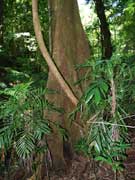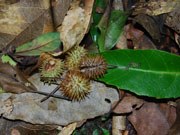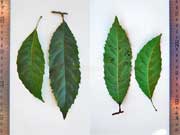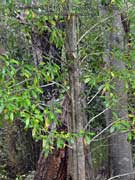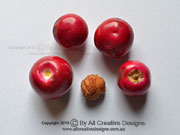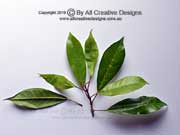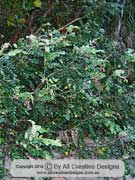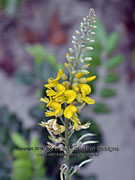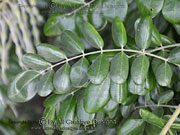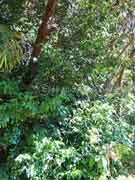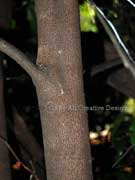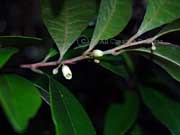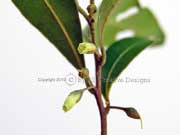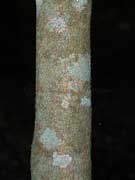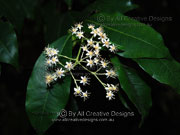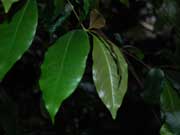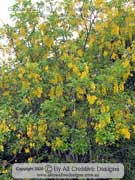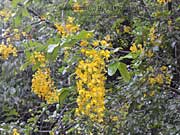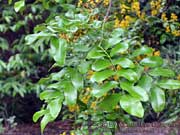
< Expand the Menu to access our Tree Identification pages.
Shrub & Tree Identification by Fruit Characteristics
Identification of native trees and shrubs including; tropical, subtropical, warm temperate and cool temperate rainforest trees of Australia's east coast. Five images for every species show tree features that enable identification in the field. Identify trees and shrubs by fruit, flower, bark and leaf characteristics. For comprehensive information on identifying Australian tree species by fruit characteristics view the: Fruit Identification Page
The natural distribution range and detailed descriptions useful in classification are given for every specimen listed on the web page below. This free and practical resource is constantly extended, revised and updated. Species in the following genera are listed in groups on our web pages: Australian Fig trees (Ficus spp.) Page 5; Australian Eucalypts (Eucalyptus spp.) Page 4; Grevilleas (Grevillea spp.) Page 6 and Lilly Pillies, Satinashes (Syzygium spp.) Page 10. Otherwise all native Australian tree species are listed by common name in alphabetical order. Select pictures for full size view (opens new browser window). Refresh the page in your browser to view updated content.
JUMP TO: Y
Wallum Bottlebrush Callistemon pachyphyllus
Wallum Bottlebrush Callistemon pachyphyllus Other names: Thick-leaved Bottlebrush
The Wallum Bottlebrush can be identified by the considerable thickness and unique shape of its leaves, which is reflected in the alternative common name. Under ideal conditions it may reach a height of 3m, but in exposed coastal sites it is a straggling shrub about 1m tall (Image 1). Bark is brown, weathering to grey, fibrous and flaky in texture (2). The beautiful crimson red or sometimes yellowish-green coloured flowers appear in tight groups towards the end of young branches and together form the characteristic bottlebrush shape. Individual flowers are dominated by a multitude of stamens that surround the longer style in the centre. The fruit is a woody capsule, measures up to 7mm in diameter and takes about twelve months to mature (3). Simple leaves with an alternate arrangement are crowded towards the end of branches. They are; up to 12cm long, narrowly oblanceolate (reverse lance-shaped) with entire margins, dark green on top, similar or only slightly paler beneath, thick, firm in texture and terminate in fine tips (4 & 5). Distribution: central NSW to subtropical Qld.
This very ornamental species is also known under the botanical name of Melaleuca pachyphylla.
See Flower Characteristics Page for explanations of definitions used.
Rainforests of Australia's East Coast, HAND SIGNED BOOKS; (Out of Stock) A practical and informative field guide to the identification of native rainforest species. More than 800 colour photographs, informative graphics, maps and detailed description of more than 300 species.
This book is a valuable information source for bushwalkers, students, gardeners and anyone with an interest in Australia’s native flora.
The book was written and illustrated by the author of the tree identification web pages.
New Holland Publishers: May 2019
ISBN: 9781925546293
Format: Paperback with PVC
Pages: 304 pp.
Size: 23 cm high x 15 cm wide
Full Colour Photography
Rainforests: Identification - Evolution - Reproduction
Dedicated photography of rainforest species including; mosses, mushrooms, lichens, slime moulds, ferns, conifers, flowering trees, climbing plants, orchids and palms enable the reader to identify commonly encountered species.
CLICK HERE FOR MORE INFORMATION
Water Gum Tristaniopsis laurina
Water Gum Tristaniopsis laurina Other names: Kanuka
This species is a common occurrence on Australia's east coast and often grows near stream banks (fresh water). Other preferred habitats include warm temperate and subtropical rainforests. It has the potential to reach a height of 30m (Image 1). Fresh bark has a very smooth texture and is grey in colour. Older bark turns brown before shedding in long strips (2). Abundant beautiful yellow flowers are up to 15mm in diameter and feature (mostly) five small rounded or more oval shaped petals. Flowering period is late spring and summer (3). The fruit is a hard capsule with 3 valves (segments) that open at the apex to disperse a large number of small papery winged seeds. Depending on climate zones fruit ripens from late summer to early winter (4). Simple leaves with an alternate arrangement are; up to 14cm long, oblanceolate (reverse lance-shaped) with entire margins, hairless, dark green on top, paler green beneath, firm and leathery in texture (5). Distribution: Victoria, NSW to central Qld. Notes: This species is used in stream bank regeneration projects, due to its hardiness and the ability to stay submerged for prolonged periods. See Leaf Characteristics Page for explanations of definitions used.
Wedge-leaved Tuckeroo Cupaniopsis wadsworthii
Wedge-leaved Tuckeroo Cupaniopsis wadsworthii Other names: Ducksfoot
As the common name suggests, this native Australian shrub is relatively easily identified by its distinctive wedge-shaped leaves. It prefers well-drained locations in tropical rainforests and other drier forest types, where it reaches a height of less than 4m (Image 1). Bark is grey in colour with a smooth and firm texture (2). The dark green and glossy foliage is supported by upright branches, which don't produce much lateral growth and give this shrub a characteristic appearance (3). The fruit, a capsule typical for the genus, is up to 2cm long and covered in short fine hair. It features 3 pronounced lobes, each containing a black seed covered in a bright orange aril (4). On mature specimens pinnate compound leaves consist of 2 to 4 leaflets, which are; up to 8cm long, wedge shaped with entire margins, glossy, medium thick and firm. Apex is truncated, base shape is cuneate. The mid vein is raised on the lower leaf surface and small domatia are visible along it (5). Distribution: Central to northern Qld.
Weeping Paperbark Melaleuca irbyana
Weeping Paperbark Melaleuca irbyana Other names: Small-leaf Paperbark, Swamp Tea Tree
As the common name implies, the weeping foliage, consisting of tiny leaves and the typical paper-like bark identify this Melaleuca species. Under favourable condition it can attain a height of a small tree (up to 10m). Dry open Eucalypt forests are preferred habitats where it can form pure stands. This Melaleuca has a restricted distribution range and is listed as an endangered species (1). The grey/brown papery bark, covering trunk and branches, is shed in large sheets (2). The densely packed capsules are produced along young branches, which continue growing. Capsules are hard woody in consistency when mature and develop a rough dimpled outer surface. The capsules reach a diameter of less than 5mm and open at the apex to release copious amount of tiny brown coloured seeds (3 & 4). Simple leaves with an alternate (spiral) arrangement are; up to 4mm long, mostly elliptic in shape with entire margins, hairless, strong, rigid and terminate in a sharp tip. A leaf stalk is absent (sessile). Distribution: Confined to a few areas in northern NSW and southern Qld. Note: This species is an attractive ornamental shrub or small tree, which is available from nurseries under the name of Weeping Paperbark.
Weeping Tea-tree Leptospermum brachyandrum
Weeping Tea-tree Leptospermum brachyandrum Note: There is no official common name recorded, but Weeping Tea-Tree is widely used.
Leptospermum brachyandrum is a tall shrub or small tree up to 6m high, which will develop a drooping canopy with age. Creek banks are its preferred habitat, but the species can adapt to dryer environments (Image 1). Bark is shades of grey and sheds in rolled-up strips to expose fresh bark, which is smooth and pinkish light brown in colour (2). Flowers, characteristic for the Leptospermum genus, feature 5 white obovate (reverse egg-shaped) petals and measure less than 1cm across. Tight groups of up to 7 individual flowers appear over late spring to early summer from axillary joints towards end of young branches (3). The conical shaped fruit is crowned by five persisting sepals and measures about 5mm in diameter at the apex. Over autumn it turns hard and woody before releasing numerous tiny light brown seeds from 3 rounded valves (4). Simple leaves with an alternate arrangement are; up to 5cm long, linear to narrow lanceolate (lance-shaped) with entire margins, hairless when mature, scented when crushed and firm in texture. Leaf apex is rounded or more acute ending in a fine sharp point (mucronate), base shape is mostly cuneate. The petiole (leaf stalk) is only 1-2mm long. Faint elliptical venation is visible on the lamina (5). Distribution: From NSW mid-north coast to northern Qld. See Flower Identification and Leaf Characteristics Page for information on terms used.
White Bauhinia Bauhinia hookeri [Lysiphyllum hookeri]
White Bauhinia Bauhinia hookeri Other names: Pegunny, Mountain Ebony
The very ornamental White Bauhinia or Pegunny is a small tree that reaches a height of up to 10m. Showy white flowers, distinctive bark and unusual foliage are identifying characteristics. It has a wide distribution range and natural habitats include subtropical and tropical types of rainforests and drier environments (Image 1). Bark at the base of older trunks is shades of grey and pale brown, thick, very rough, deeply furrowed/fissured and scaly (2). The scented flowers reach a diameter of more than 60mm and feature 5 white (with pink hues) and crinkled petals. Stamens consist of filaments up to 50mm long that are crowned by prominent red coloured anthers. The style in the centre supports a rounded green coloured stigma (3). The flat pods are irregular in shape and reach a length of about 20cm (often shorter) and contain a number of flattened shiny brown seeds up to 12mm long (4). The unusual compound leaf consists of 2 leaflets that are attached without a stalk (sessile). Leaflets are; up to 5cm long, asymmetric with entire margins, hairless, relatively thin and soft. Fine palmate venation radiating from point of attachment is visible on both leaflet surfaces. Emerging foliage flushes in deep pink or red (5). Distribution: South eastern to northern Qld.
White Beech Gmelina leichhardtii
White Beech Gmelina leichhardtii
This stately and attractive tree inhabits subtropical and littoral rainforests, where it attains a height of up 40m (Image 1). Bark at the base of older trunks becomes rough, scaly and fissured. It is mottled grey in colour and firm in texture (2). The vivid blue coloured fruit (a drupe) is roughly globe-shaped and reaches up to 25mm in diameter. It is fleshy and contains a single brown and hard-shelled seed (3). Growing buds, petiole and twigs are densely covered in fine rusty brown hair (4). Simple leaves with an opposite arrangement are; up to 20cm long, ovate in shape with nearly entire margins (compared to the strongly toothed leaf margins of juvenile trees) (5), dark green glossy, hairless except for veins on upper surface, paler green, hairy beneath, firm and slightly rough in texture. Venation is clearly visible with the centre vein being strongly raised on lower leaf surface. Petiole (leaf stalk) is up to 25mm long (5). Distribution: From the south coast of NSW to central Qld.
Descriptions and all images copyright ©2023 by www.allcreativedesigns.com.au world wide rights reserved.
Click or Tap Images for Full Size View (opens new browser window)
White Bolly Gum Neolitsea dealbata
White Bolly Gum Neolitsea dealbata
This species is very similar to the Green Bolly Gum Neolitsia australiensis (Page 6), but at less than 10m tall has a smaller growth habit. It is a common understorey shrub or small tree found in different types of rainforests and surrounding transition zones (Image 1). Bark is mid brown in colour, firm and becomes fissured at the base of older trunks (2). Interesting flowers are a golden yellow colour and appear along older branches in late summer (3). The fruit is a small globe-shaped drupe less than 1cm in diameter. It turns black at full maturity and contains a single brown seed (4). Simple leaves develop in a whorl beneath the growth bud and turn alternate thereafter. They are; up to 20cm long, mainly obovate (egg-shaped) with entire margins, dark green, glossy on top, white waxy beneath, strong and firm in texture. The petiole (leaf stalk) is up to 3cm long and covered in fine rusty brown hair. Veins on underside of leaf and growth buds are also hairy (5). Distribution: Ranging from the NSW central coast to central Qld. Note: The Green Bolly Gum has hairless and narrower, elliptic to lanceolate (lance-shaped) leaves.
White Booyong Argyrodendron trifoliolatum
White Booyong Argyrodendron trifoliolatum Other names: Brown Tulip Oak
The White Booyong or Brown Tulip Oak is a very tall tree species reaching up to 45m in height and occurs within warmer subtropical rainforests. Older specimens develop large buttress roots and a straight trunk (Images 1 & 2). Bark is light brown in colour, rough and firm in texture, with prominent vertical fissures developing at the base of trunks (3). Alternately arranged compound leaves consist of three leaflets (trifoliolate). They are; up to 14cm long, oblong to elliptic in shape with undulating (wavy) margins, dark green and glossy on top, paler with a copper coloured sheen beneath (good identification feature), hairless and rather thin but strong in texture. Leaflet apex is short acuminate, base shape is cuneate. Venation is prominent with the centre vein being raised on both leaflet surfaces.
The strong petiole is up to 50mm long (Photos 4 & 5). Distribution: From the mid-north coast of NSW to Qld. (See Leaf Characteristics Page for explanations of botanical terms used in descriptions.)
White Carabeen Sloanea langii
White Carabeen Sloanea langii
This tall tree species can reach a height of 40m and is found in upland and lowland types of tropical rainforests, where it often forms the highest stratum of the canopy. Buttress roots are often present on mature specimens (1). Bark is brown in colour and has rough texture due to small blisters (lenticels) covering the surface (2). The fruit (a capsule) is densely covered in yellow coloured bristles, which are up to 10mm long and detach when handled. The mature fruit will split into 3 or 4 segments (valves), each releasing an oval shaped seed, which is covered in an yellow to orange/red coloured aril (depending on maturity and length of exposure). Fruit ripens over late winter into spring (3). Simple leaves with an alternate (spiral) arrangement are: up to 16cm long, obovate or broadly oblanceolate (reverse lance-shaped) with crenate or shallow toothed to nearly entire margins, dark green, dull on upper surface, paler green beneath, hairless, strong with a dry and thick paper-like texture. Leaf apex is acute ending in a blunt tip, base shape is cuneate. The strong petiole is up to 4cm long. Venation is prominently raised on lower leaf surface (4 & 5). Distribution: From central to northern Qld. See also: Yellow Carabeen (Sloanea woollsii) lower on this page.
See
Leaf -
Flower - Fruit - and Bark Identification Web Pages for explanations of botanical definitions and concepts.
Select images for Full Size View. (Opens new browser window).
Use the Key to Species, which is based on leaf characteristics, to identify native trees and shrubs found on Australia's east coast.
White Cedar Melia azedarach
White Cedar Melia azedarach
This medium sized tree has a wide distribution range and originates in diverse types of native forests, which include different forms of rainforests. It is deciduous over winter and produces vibrant green new foliage in early spring (Image 1). Bark is a two tone grey and white, tough, firm and fissured (2). Mauve and pleasantly scented flowers appear in spring and are followed by olive shaped fruit that turn yellow when fully ripe. After leaf fall in autumn only bunches of eye-catching yellow fruit will remain on the tree (3 & 4). The large compound leaf with bipinnate (twice divided) and sometimes tripinnate features can consist of more than seventy small leaflets. They are; up to 5cm long, ovate (egg-shaped) with toothed to nearly entire margins, mostly hairless when mature and relatively thin. Leaflet base shape is often asymmetric (5). Distribution: From the NSW south coast to Qld, NT & WA. Notes: Fruit is poisonous to humans and livestock, but is eaten safely by a range of birds. This species is a popular shade or street tree.
White Dogwood Ozothamnus diosmifolius
White Dogwood Ozothamnus diosmifolius Other names: Rice flower, Sago Flower, Wild Rosemary, Pill flower, Sago Bush, Tick Bush
This very adaptable shrub is found in diverse habitats that include the margins of rainforests and many drier more open environments. Depending on conditions it can be up to 4m tall, but a height of about 1.5 to 2m is more usual. This species is known under a range of different common names, with the terms Rice Flower and Sago Flower being used by nurseries and the cut-flower trade (Picture 1). Bark on older stems is brown, rough and furrowed (2). Numerous ‘flowers’ are borne on very ornamental panicles (a type of multi-branching inflorescence) appearing at the end (terminal) of the upright vegetative branches. Each flowering branch forms an umbrella (corymb) shape. Resembling ‘flower buds’, the composite flower heads feature about 20 individual tiny bisexual flowers (florets) in the centre, which become visible after the surrounding white coloured bracts (involucres) opened.
Bracts can also be shades of pink (3 & 4). Simple leaves with an alternate arrangement are; less than 20mm long, linear in shape with in-rolled margins, dark green and scabrous (rough) on top, whitish and densely hairy beneath. Leaves emit a pungent odour when crushed. Young branches are also hairy (5). Distribution: southern NSW to central Qld, from coastal to inland regions.
White Elderberry Sambucus gaudichaudiana
White Elderberry Sambucus gaudichaudiana
This sprawling native shrub propagates from underground rootstock with stems reaching a height of 3m. It naturally occurs on margins of rainforests, adjacent tall forests, on stream banks and is often found in regrowth (Image 1). Bark is greyish brown in colour and firm in texture with a covering of scattered small corky blisters (2). Masses of pure white and scented flowers are borne on large umbrella shaped panicles and bloom over spring (3). The globe-shaped fruit (a berry) measures up to 5mm in diameter and is purple in colour when fully ripe. It contains up to 6 small hard seeds surrounded by a yellow pulp (4). Pinnate or partly bipinnate compound leaves feature up to 11 separate leaflets, which are; up to 14cm long, ovate (egg-shaped) or broadly lanceolate (lance-shaped) with finely toothed margins, mid-green and rather dull on top, paler beneath, covered in short stiff hair, thin and soft in texture. Leaflet apex is acute to acuminate, base shape is cuneate (wedge-shaped) to nearly rounded and often slightly asymmetric. Venation is clearly visible on both surfaces (5). Distribution: Widespread in Vic, NSW and Qld. Note: Additional features in identification are small leaflets sometimes found at the base of opposing leaves (not shown).
White Euodia Melicope micrococca
White Euodia Melicope micrococca Other names: Hairy Doughwood
The White Euodia or Hairy Doughwood is a medium to tall native tree species with an upright trunk up to 30m tall. It is a common occurrence in different types of rainforests and often a pioneer species in regrowth areas (Image 1). Bark is light grey to pale brown in colour and has a firm texture. Bark on the lower trunk of older trees becomes rough and (soft) corky with blisters and horizontal fissures (2). Small white to cream coloured flowers are borne on large panicles and blossom over summer (3). The small brownish fruit ripens from late summer into autumn and contains up to 4 black seeds (4). The (trifoliolate) compound leaf consists of 3 leaflets, which are; up to 13cm long, broadly elliptic or obovate (reverse egg-shaped) with mostly entire margins, sparsely hairy on the upper surface, softly hairy beneath (densely hairy on mid vein), rather thick and firm in texture (5). Distribution: Mid-north coast of NSW to central Qld. See also Pink Doughwoood Melicope elleryana (Page 8) and Doughwood Acronychia octrandra (Page 3).
White Hollywood Auranticarpa rhombifolia
White Hollywood Auranticarpa rhombifolia [Pittosporum rhombifolia] Other names: Holly-leaved Pittosporum, White Holly, Queensland Pittosporum and Diamond-leaved Pittosporum
Auranticarpa rhombifolia is known by a range of common names, mainly due to its wide distribution range and popularity as an ornamental species. It is naturally found in subtropical and drier types of rainforests, where under favourable conditions it can reach a height of 20m (Image 1). Bark is a whitish grey in colour with a rough and firm texture (2). Pure white flowers are arranged on large and crowded panicles covering the whole tree in late spring. Fragrant flowers are up to 15mm in diameter and feature five oblong shaped petals. The prominent stamens consist of pale brown coloured anthers supported by sturdy filaments (3). Masses of yellow to orange coloured fruit (capsules) ripen in autumn and split to disperse 1 to 3 shiny black seeds (4). Simple emerging leaves are arranged in a whorl formation and turn alternate when maturing. They are; up to 12cm long, characteristically diamond shaped with irregular toothed margins towards the apex, hairless, smooth and quite firm in texture. Apex is short acuminate, base shape is cuneate to attenuate. Mid vein is raised on lower surface and fine venation becomes apparent when the leaf is held against the light (5). Distribution: Naturally occurring from northern NSW to tropical Qld.
green guide TREES OF AUSTRALIA
How to recognise Australian tree families and genera.
A practical field guide to the identification of native species. More than 200 full colour photographs and detailed descriptions explaining leaf, bark, flower, fruit and other tree characteristics. The guide was written and illustrated by the author of these web pages.
New Holland Publishers: January 2016
Format: Paperback with PVC
Pages: 128 pp.
Size: 13 cm wide x 18 cm high
First Edition, Hand Signed Copies
CLICK HERE FOR MORE INFORMATION White Laceflower Tree Archidendron hendersonii
White Laceflower Tree Archidendron hendersonii
This beautiful native tree inhabits subtropical and littoral (coastal) rainforests. As an understorey species, it reaches less than 15m in height (Image 1). Bark on older specimens is a greyish brown in colour with a rather rough and flaky texture. Juvenile bark is firm with shallow fissures (2). Masses of gorgeous but short-lived flowers bloom in early spring. Bundles of stamens change from white to yellow over a short period of time and are up to 6cm long (3). The fruit is a curled pod, bright orange on the outside and yellow on the inside. The hard pod splits along its sides to reveal up to 6 black seeds with a very shiny, polished-like surface (3). The unusual bipinnate compound leaf consists of only two (sometimes 4) pinnae with 4 to 6 leaflets each. Leaflets are; up to 12cm long, lanceolate (lance-shaped) with entire margins, dark green and glossy on top, paler and dull below, hairless, soft and smooth, but strong (thin leathery) in texture. Leaflet apex is acute with a fine point featuring a minute bristle; the asymmetric base shape is a good identification characteristic. The petiole (primary leaf stalk) is up to 5cm long and features a small gland about half way. Petiolules (leaflet stalks) are swollen and only up to 2mm long. Venation is clearly visible showing a noticeably raised centre vein on lower leaflet surface (5). Distribution: NSW north-coast to southern Qld.
To locate related species, view: Species List Botanical, and look up the relevant genus.
White Mountain Banksia Banksia integrifolia ssp. monticola
White Mountain Banksia Banksia integrifolia ssp. monticola
This beautiful tree and other Banksia species are easily recognised by their unusual woody fruiting structures (Image 4) that remain attached to branches for a long time. As the name implies, this subspecies is only found in mountainous areas, where it inhabits various environments ranging from open Eucalypt forests to cool-temperate rainforests. Exceptional specimens can reach a height of 25m, but a height of less than 10m is likely when growing within in a cool rainforest habitat (Image 1). Bark at the base of older trunks is deeply fissured and scaly, firm in texture and light grey/brown in colour (2). The cylindrical flower heads are up to 12cm long and produce masses of pale yellow coloured flowers with prominent straight or slightly curved styles (3). The dry fruits (follicles) are horizontally attached to a vertical axis, the flower spike, and become woody at maturity. Follicles are grey in colour, thick-walled, up to 20mm long and split to disperse 2 winged seeds (4). Simple leaves form a whorl below the growing bud. They are; up to 13cm long, narrow elliptic or more oblanceolate (reverse lance-shaped), dark green and hairless on top, finely whitish hairy beneath, thick and strong. Leaves of mature trees have entire (smooth) margins, whereas juvenile trees feature sharply toothed margins (5). Distribution: At higher altitudes from the Blue Mountains NSW to southern Qld.
Note: The Mountain Banksia is a close relative (subspecies) of the better known Coast Banksia (B. integrifolia subsp. integrifolia) Page 3. Leaves of the White Mountain Banksia (subsp. monticola) are considerably longer and narrower. The common name Mountain Banksia is also used for Banksia canei, a shrub native to mountainous regions of Victoria.
White Paper Daisy Coronidium elatum
White Paper Daisy Coronidium elatum
Under ideal conditions this attractive native shrub with a wide distribution range can attain a height of up to 2m. It naturally has a compact, upright and densely branched growth habit, preferring sunlit positions in tall open forests and woodlands (Picture 1). Bark on the trunk of older specimens becomes rough and fissured. It is brown in colour weathering to grey, whereas young branches are densely covered in white and softly woolly hair (2 & 3). Large flower heads are borne on stalks that are densely hairy. Flower heads appear at the end of branches and measure up to 5cm in diameter. Numerous pure white bracts with a pointed apex are up to 2cm long and surround the yellow orange coloured disc in the centre (4). Simple leaves with an alternate (spiral) arrangement are; up to 12cm long, elliptic or lanceolate (lance-shaped) with entire or wavy margins, dull green, slightly hairy on top, whitish, woolly hairy beneath and very soft in texture. Leaf apex is acute, base shape is cuneate. The petiole (leaf stalk) is up to 2cm long and clothed in white, woolly hair. Centre vein is sunken on the upper and prominently raised on the lower surface, lateral veins only visible on top. Distribution: Vic., NSW to southern Qld. Note: This species is a beautiful ornamental plant.
White's Tea-Tree Leptospermum whitei
White's Tea-Tree Leptospermum whitei
The White's Tea-Tree is a sturdy, often multi-stemmed shrub reaching up to 5m in height under ideal conditions. Preferred habitats are margins of coastal swamp forests and tidal waterways (Pictures 1 & 2). Young bark is mid-brown in colour turning grey with age and has a rough fibrous texture. Old bark sheds in short papery strips (3). Flowers appear in tight clusters over spring to early summer and feature 5 bright white and obovate (reverse egg-shaped) petals, characteristic for the Leptospermum genus. They measure up to 12mm in diameter when fully opened (4). Young green stems are covered in short fine hair. Simple leaves with an alternate arrangement are; up to 3cm long, elliptic in shape with entire margins, hairless, dark green, rather dull on top, thick and stiff in texture. Venation is obscure except for mid vein. Leaf apex is acute ending in a blunt point, base shape is cuneate. The petiole (leaf stalk) is nearly nonexistent or 1-2 mm long (5). Distribution: From the mid north coast of NSW to Qld. Note: The species is named after botanist Cyril Tenison White (1890-1950), the White Tea-Tree is Kunzea ericoides. See Flower Identification and Leaf Characteristics Page for information on terms used.
Wild Cherry Exocarpos cupressiformis
Wild Cherry Exocarpos cupressiformis Other names: Native Cherry, Cherry Ballart
The appearance of this shrub or small tree resembles that of a young Cypress pine, hence the botanical species name of
cupressiformis. It is a common understorey species, less than 10m high, found in dry open forests and woodlands (Image 1). Bark on trunks of older specimens is rough, furrowed and tessellated (scaly), and has some resistance to low intensity fires. It is grey brown in colour and has a
crumbly texture (2). The minute flowers are borne on short spikes and vary in colour from greenish to cream or pale yellow (3). The unusual fruit is a small nut suspended beneath the swollen and fleshy (flower) stalk, which turns orange to deep red in colour when fully ripe. This fleshy stalk is edible, whereas the hard nut should not be eaten. The fruit, including the part of the fleshy stalk, is about 1cm long
(4). A magnifying glass is needed to observe the tiny scale-like leaves, which are roughly triangular in shape and less than 1mm long. Branchlets are mid to dark green in colour and show a ribbed surface (5). Distribution: Tas, SA, Vic., NSW & Qld.
Wild May Kunzea flavescens
Wild May Kunzea flavescens
In full flower this attractive shrub becomes very noticeable in its habitat of dry open forests and woodlands. It attains a height of up to 4m (Image 1). Bark is brown in colour and has a rough, fibrous and fissured texture (2). Tight groups of individual flowers appear at the end of young branchlets over spring. They are dominated by numerous white filaments supporting small yellow anthers. The prominent bell-shaped calyx features 5 pointed sepals (lobes) (3). This image shows the developing fruit, a capsule which becomes dry and woody at full maturity. It is attached to the stem without a stalk (sessile) and shows the persistent calyx lobes at the apex (4). Simple leaves with an alternate (spiral) arrangement are; less than 1cm long, broadly reverse lance-shaped (oblanceolate) with entire margins, hairless on top, often finely hairy beneath, scented when crushed, rather thick and strong in texture. The stout petiole (leaf stalk) is up to 2mm long and yellowish. Distribution: South-east Qld. Note:
Wild Parsley Lomatia silaifolia
Wild Parsley Lomatia silaifolia Other names: Crinkle Bush, Fern-leaved Lomatia, Parsley Bush
This small native shrub grows to height of 2.5m and naturally has compact growth habit with dense foliage (Image 1).
Bark is reddish brown in colour showing fine longitudinal fissures (2). Up to 30 beautiful white flowers are arranged on a long spike and bloom over winter (3). The fruit is a flattened follicle, which is up to 4cm long and dark brown to black in colour. It contains numerous seeds that are enclosed in a papery wing and up to 20mm long (4).
Alternately arranged pinnate compound leaves feature between 7 and 11 leaflets. Leaflets are; up to 7cm long, elliptic or lanceolate (lance-shaped) with deeply lobed (up to 5 lobes) and toothed or just irregular toothed margins, mostly hairless and thin but firm in texture. Leaf apex can be acute with a blunt point or rounded. Leaves are dull mid-green in colour and when crushed release a scent that is reminiscent to parsley (5). Distribution: NSW central coast to southern Qld. This species is a beautiful ornamental plant.
Descriptions and all images copyright ©2023 by www.allcreativedesigns.com.au world wide rights reserved.
Click or Tap Images for Full Size View (opens new browser window)
Willi Willi Laurel Cryptocarya williwilliana
Willi Willi Laurel Cryptocarya williwilliana Other names: Small-leaved Laurel
This tall shrub or small tree is a rare occurrence due to its restricted distribution range and habitat destruction. It is found as an understorey species within dry rainforests, where it reaches a height of up to 8m (1). Bark is brown in colour and marked by small irregular ridges (2). Up to 7 tiny inconspicuous flowers are borne on small racemes about 2cm long, which appear over spring from terminal or from axillary buds towards the end of young branches. The obovoid (pear-shaped) perianth (floral tube) is up to 4mm long and opens into 6 pointed lobes at the apex. Flowers measure 3-4mm in diameter when fully opened (3). Branchlets and petioles (leaf stalks) are densely covered in fine brown hair. The dense and glossy dark green foliage consists of small leaves that are mostly less than 3cm long. Simple leaves with an alternate arrangement are; broadly elliptic or ovate with entire margins, dark green glossy on top, paler beneath, hairless and finely rough in texture due to a raised network of fine veins (reticulate). Leaf apex is short acuminate ending in a rounded tip, base shape is cuneate (wedge-shaped) (4 & 5).Distribution: Only in the Willi Willi area on the upper Macleay river and in New England N.P., NSW mid-north coast. Note: This species is a member of the Laurel family (LAURACEAE). Find related species under the genus of Cryptocarya on the Botanical Species List. An attractive ornamental tree, seedlings are available from online nurseries.
Willow-leaved Hakea Hakea saliciifolia
Willow-leaved Hakea Hakea saliciifolia
Under favourable conditions the Willow-leaved Hakea is able to reach a height of 15m. The species is found on margins of cooler rainforests and in wet tall Eucalypt dominated forests (Image 1). Bark is a reddish brown (especially freshly exposed bark) in colour with a rough and flaky texture (2). The hard woody fruits are up to 2.5cm long, with irregular warts and bumps covering the outer surface. Each follicle contains 2 papery winged seeds. The rather obvious fruit of prior seasons remains on older branches and is a good identification feature (3). New growth flushes in attractive salmon colours and is finely hairy (4). Mature simple leaves with an alternate arrangement are: up to 12cm long, narrow elliptic to narrow lanceolate (lance-shaped) with entire margins, hairless, mid green and rather dull above, slightly paler beneath, smooth and firm to stiff in texture. Leaf apex is acute, base shape is attenuate. Venation is faint with laterals veins just visible (5). Distribution: Mountainous areas from NSW mid-north coast to Qld border.
Wing-leaved Tulip Harpullia allata
Wing-leaved Tulip Harpullia allata
This understorey shrub or sometimes small tree prefers a mountainous habitat within subtropical rainforests, where it can reach a height of up to 6m. The distinctive foliage, consisting of large compound leaves with a winged leaf stalk and rachis, make this species relatively easy to identify (Image 1). Bark on older stems is finely rough in texture due to small blisters and fine ridges covering the surface. Colour is a reddish brown, if not obscured by mosses and lichen (2). Globe-shaped flower buds are hairy on the outside and appear sparsely along racemes between 5 and 12cm long. The image also shows a pollinated flower where the 5 rounded sepals persist, but petals and stamens have fallen (3). The fruit is a capsule with 2 distinctive lobes measuring up to 3.5cm in width and up to 2cm in length. It changes from green to a yellowish brown colour with full maturity (4). Large pinnate compound leaves with up to 10 leaflets can be close to 40cm long. Leaflets are; up to 14cm long, varied in shape from elliptic or oblong to oblanceolate (reverse lance-shaped) with prominently toothed margins, glossy, dark green, mostly hairless, strong and slightly leathery in texture. The rachis (centre axis) and the up to 10cm long petiole (primary leaf stalk) feature a wing with toothed margins. Venation is clearly visible and prominently raised on lower leaflet surface. Distribution: From NSW north coast to southern Qld.
Winged Broom Pea Jacksonia scoparia
Winged Broom Pea Jacksonia scoparia Other names: Dogwood, Broombush, Broom-like Jacksonia
This hardy species is very adaptable to different environments. Habitats range from coastal locations receiving high rainfall averages to dry woodlands on the western slopes of the Great Dividing Range. This species is a rather inconspicuous shrub or small tree up to 12m tall, but it becomes noticeable when in full flower over late spring and summer (Image 1). Bark is brown and becomes rough, fibrous on the trunks of older specimens (2). Flowers, characteristic for the Pea & Bean Family (FABACEAE/FABOIDEA), are pale to deep yellow (nearly orange) and up to 1cm in diameter. Up to 6 separate flowers are borne on small racemes emerging at the end of branches (3). The fruit, a flattened pod, is up to 1.5cm long and turns brown in colour when fully mature. It is oblong in shape and covered in long fine whitish hair (4). Leaves are apparently absent on older plants, but might be present on saplings. Branchlets are typically dark greyish green, flat-sided, ribbed or flanged (winged). Distribution: From NSW south coast to southern Qld, reaching western inland regions.
Woolly Brush Apple Mischocarpus lachnocarpus
Woolly Brush Apple Mischocarpus lachnocarpus Other names: Woolly Pear-fruit
The Woolly Brush Apple or Woolly Pear-fruit is a small tree species found within mountainous rainforest areas (Image 1). Bark is firm, rather smooth and a dark green grey in colour (2). New foliage appearing in spring is a bright yellowish green (3). Small yellow flowers are 3 to 5mm long and borne on a raceme up to 25cm in length. Fertilised flowers produce an orange, hairy pear-shaped fruit (4). (Bifoliolate) compound leaves feature 2 (sometimes up to 4 leaflets), which are; up to 13cm long, mostly elliptic in shape with entire margins, hairless, semi-glossy on top, firm and stiff in texture. Lower leaflet surface, petiole (primary leaf stalk) and young stems are all covered in fine brown hair. The rounded or bluntly pointed leaf apex has a small notch with a tiny bristle. Venation is clearly visible with a strongly raised mid vein covered in hair (4 & 5). Distribution: Northern NSW to northern Qld.
Yellow Acronychia Sarcomelicope simplicifolia [Yellow Aspen]
Yellow Acronychia Sarcomelicope simplicifolia subsp. simplicifolia Other names: Yellow Aspen
This medium sized and widely distributed tree can attain a height of up to 25m. Habitats include subtropical and tropical rainforests in coastal and mountainous areas. This tree shares the common name Yellow Aspen with the species Pitaviaster haplophyllus, listed below (Image 1). Bark is dark brown or more grey in colour with a rough and fissured texture (2). Single or up to 4 small and cream coloured flowers are supported by a primary stalk that is softly hairy (3). The somewhat fleshy fruit (a drupe) is yellow to light brown in colour, measures up to 15mm in diameter and contains shiny black seeds up to 5mm long (4). Simple leaves with an opposite arrangement are; up to 17cm long, broad elliptic or oblong in shape with entire margins, hairless, dark green and glossy on top, firm, smooth in texture and scented when crushed. Petiole (leaf stalk) is whitish in colour, thin, slender and can be more than 5cm long (5). Distribution: NSW south coast to north Qld.
Yellow Aspen Pitaviaster haplophyllus
Yellow Aspen Pitaviaster haplophyllus
Shady locations within tropical rainforests are habitats for this attractive tall shrub or small tree. As an understorey species it can reach a height of 8m but will be considerably smaller when planted in more open positions. It shares a name with the more common and widely distributed Yellow Acronychia (Sarcomelicope simplicifolia subsp. simplicifolia) listed above. Both species are related and belong to the Acronychia-Euodia-Melicope group in family RUTACEAE. These tree species are not related to the deciduous Aspen trees of North America and Europe (Genus Populus in family SALICACEAE) (Picture 1). Bark on older stems is dark grey, firm and rough due to irregular vertical ridges and protrusions. Bark on young branches (branchlets) is brown and smoother (2). Flowers are borne on panicles emerging from leaf axils (axillary buds) towards the end of young branches. Flowers are supported by finely hairy individual stalks (pedicels) about 10mm long. The four petals, with pointed and in-curving tips, are up to 3mm long, whitish, cream or yellow coloured (depending on maturity). Petals and calyx are covered in short fine hair (pubescent) (3). Simple leaves with an opposite arrangement are; up to 18cm long, oblanceolate (reverse lance-shaped) with entire margins, hairless, dark green, very glossy on top, paler green beneath, scented when crushed, smooth and leathery in texture. The petiole (leaf stalk) shows a conspicuous swelling at the apex and is about 2.5cm long. Reticulate venation is clearly visible on lower leaf surface (5). Distribution: tropical north Qld.
Yellow Boxwood Planchonella myrsinodendron [Pouteria myrsinodendron]
Yellow Boxwood Planchonella myrsinodendron Other names: Northern Yellow Boxwood
This medium sized tree inhabits coastal and upland tropical rainforests. The common name Yellow Boxwood is also used for the related species (P. pohlmaniana) and refers to the hard yellowish timber used for woodworking. The genus Pouteria was reclassified as Planchonella (APC) (Image 1). Bark is greyish brown on the outer surface, firm and marked by small fissures showing the brown underlying fresh bark (2). The fleshy fruit contains a single seed and is classified as a berry. Colour of the fruit changes from green to yellow, than red and finally black at full maturity. It is reverse egg-shaped (obovoid) and reaches a length of about 2.5cm (3 & 4). Simple leaves with an alternate arrangement are; up to 17cm long, obovate (reverse egg-shaped) with entire margins, dark green, glossy on upper surface, silvery or brownish green beneath, strong and firm in texture. Lateral veins are prominent on both leaf surfaces. The petiole (leaf stalk) is up to 2cm long and, characteristic for the genus, may exude a small amount of milky sap when broken (4 & 5). Distribution: northern Qld. See also: Yellow Plumwood Planchonella myrsinifolia below on this page.
To locate trees by botanical name or to find related species go to:Species List Botanical, which also shows all family names.
Click Images for Full Size View
Yellow Carabeen Sloanea woollsii
Yellow Carabeen Sloanea woollsii
This majestic very tall tree species can grow to more than 50m in height and is often part of the highest canopy in subtropical rainforests. It has been extensively logged for its valuable timber. The specimen shown in picture 1 is being overtaken by a Strangler Fig (Ficus watkinsiana) (Pictures 1 & 2). Older trees develop large sail-like (plank) buttress roots. Bark is grey brown and finely rough at the base, turning to grey with a smoother texture further up the trunk (3). The fruit (a capsule) is covered in sturdy spikes up to 20mm long. It features 2 valves (segments), each containing a seed covered in a yellow or reddish aril (4).
Simple (1-foliolate) leaves with an alternate arrangement are; up to 16cm long, elliptic to lanceolate (lance-shaped) with toothed margins, hairless, smooth and strong in texture. Young shoots and petioles (leaf stalks) are covered in fine hair. On the lower leaf surface hairy bristles (domatia) are visible along the mid rib at junctions of lateral veins (5). Distribution: from the mid-north coast of NSW to central Qld. See also: White Carabeen (Sloanea langii), above on this page and Maiden's Blush (Sloanea australis) Page 7.
Yellow Hollywood Vitex lignum-vitae
Yellow Hollywood Vitex lignum-vitae Other names: Lignum-vitae, Satinwood
Under ideal conditions this tree is able to reach a height of 25m and develops a fluted trunk with age. It is found in subtropical to tropical and drier forms of rainforests (Image 1). Bark colour is cream to light brown with a fissured and flaky texture (2). Flowers are borne on small cymes and measure about 10mm in length. The purple coloured and hairy corolla (fused petals) features 4 rounded lobes at the apex. The 4 white filaments extend beyond the lobes and are crowned by prominent anthers. The hairy calyx (base of flower) shows an entire (flat) rim and only loosely envelops the base of the corolla (3). The beautiful shiny red and globe-shaped fruit (a drupe) reaches a diameter of 18mm. Mealy fruit flesh surrounds a hard-shelled stone that can contain up to 4 seeds (4). Simple leaves with an opposite arrangement are; up to 12cm long, mostly lanceolate (lance-shaped) with entire margins, hairless and firm when mature. Leaf stalks (petioles) are hairy and up to 25mm long. Domatia are visible along the centre vein as small swellings on the upper and as cavities on the lower leaf surface. Leaves of saplings are angled or lobed (5). Distribution: Northern NSW to north Qld. Note: The name Lignum-vitae is also used for other unrelated native tree species and refers to the South American tree; Lignum-vitae.
Yellow Necklacepod Sophora tomentosa
Yellow Necklacepod Sophora tomentosa Other names: Silver Bush
This eye-catching plant colonises the first sand dunes above the high tide mark and is able to flourish on fresh sand with a high salt content. It is a sturdy tall shrub that reaches a height of 5m. This species belongs to the Pea & Bean Family (FABACEAE/FABOIDEA), members of which have the ability to form symbiotic relationships with bacteria and thereby fix atmospheric nitrogen in the soil. The specimen shown is growing on the margins of coastal (littoral) tropical rainforest (Photo 1). Bark on older stems is brown, firm and marked by prominent blisters (2). The raceme is up to 50cm long and produces individual bisexual flowers, which mature from the base, over an extended period of time. Flowers are bright yellow and including the hairy calyx (base) up to 30mm long. They feature a standard (large top petal), wings (two side petals) and a keel (two fused petals surrounding the female carpel and male stamens), these modified petals are typical for the family (3). The common name refers to the fruit having a necklace like appearance. The abundantly produced pods are finely hairy and reach a length of 16cm (4). The pinnate compound leaf consists of up to 19 leaflets with an opposite arrangement and a terminal leaflet is always present. Leaflets are; up to 6cm long, ovate (egg-shaped) or broadly elliptic with entire margins, dark green above (when mature), greyish green and silvery hairy beneath, smooth and soft in texture. Scraping the pods or bark of young branches emits a strong bean scent, but all parts of the plant are reported to be poisonous (5). Distribution: Close to the beach, from the mid-north coast of NSW to northern Qld and NT. Note: Sophora tomentosa is listed as an endangered species in NSW. It is an attractive ornamental species for sandy soils.
Yellow Plumwood Planchonella myrsinifolia [Pouteria myrsinifolia]
Yellow Plumwood Planchonella myrsinifolia Other names Blunt-leaved Coondoo
The Yellow Plumwood or Blunt-leaved Coondoo is a small native tree species growing to a height of 15m and inhabits different forms of rainforests (Image 1). Bark is brown in colour with a rough and grainy texture, featuring numerous fine longitudinal ridges (2). Yellowish green and cylindrical shaped flowers measure only up to 3mm wide by 7mm long. They are supported by solitary stalks less than 1cm long (3). Young stems, flower stalks and petioles (leaf stalks) are covered in very fine and short hair. Developing fruit is shown to the bottom right in the image (4). Simple neatly alternately arranged (two-ranked) leaves are; up to 10cm long, elliptic to oblanceolate (reverse-lance-shaped) with entire margins, dark green with a satin sheen on top, paler underneath, medium thick, strong, somewhat leathery and on this specimen mostly hairless. Apex is bluntly pointed, leaf base shape is attenuate. Mid vein is raised on lower surface and hairy at the base, otherwise venation is rather faint (5). Distribution: NSW central coast to southern Qld. See also: Black Apple (Planchonella australis) Page 1.
Yellow Satinheart Bosistoa transversa
Yellow Satinheart Bosistoa transversa
This elegant small to medium sized tree species reaches a height of 15m and occurs in warmer subtropical rainforests (Image 1). Bark is brown in colour (grey patches are lichen), and features small longitudinal fissures and some blisters (2). White to cream coloured flowers are borne on large panicles emerging at the end of branches. Flowers feature 5 ovate petals and 10 prominent stamens with solid flattened filaments and brown anthers (3). The fruit is a small woody follicle less than 1.5cm long with distinct horizontal ribs showing on the surface (4). Compound leaves consist mostly of three leaflets (trifoliolate), sometimes only 2 or reduced to a single leaf. Leaflets are; up to 12cm, broad elliptic to lanceolate (lance-shaped) with entire margins, hairless, rather thick and strong in texture. Venation is very prominent on lower leaflet surface (5). Distribution: northern NSW to central Qld.
Yellow Shower Cassia queenslandica
Yellow Shower Cassia queenslandica
This very ornamental native tree reaches a height of up to 10m. It is found as an understorey species within and on the margins of wet tropical rainforests. The neatly arranged foliage and masses of yellow flowers are distinctive features for this species and others belonging to the genus Cassia (Photo 1). Bark on the trunk is relatively rough with horizontal lines of blisters and vertical fissures, which show the brown colour of the fresh underlying bark (2). Bright yellow flowers are borne along drooping racemes, which can be more than 30cm long. Individual flowers are supported by straight and rigid stalks (pedicels) 30 to 40mm long. The 5 obovate (reverse egg-shaped) petals abruptly taper at the base and are up to 15mm long. The developing fruit pod can be seen in the centre of some flowers (3). The neatly arranged foliage consists of pinnate (once-divided) compound leaves that reach a length of 25cm or more. Up to 10 (sometimes 12) individual leaflets have an opposite arrangement and when mature are; up to 6cm long, elliptic or more oblong in shape with entire margins, hairless, glossy, smooth and leathery in texture. Intricate fine venation is visible of both leaflet surfaces (5). Distribution: Wet tropical east-coast of northern Qld (Townsville to the Daintree). Note: The common name Cassia is also used for species belonging to the genus Senna.

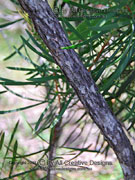


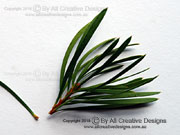
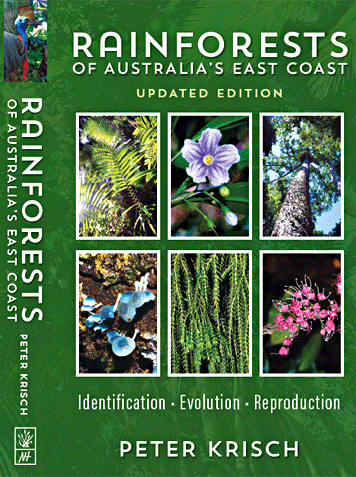
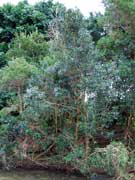
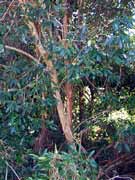
tn.jpg)

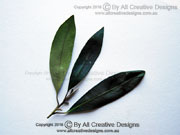

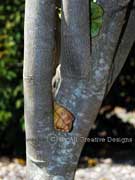
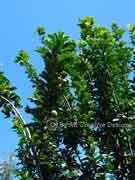

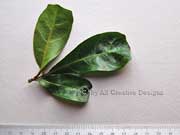


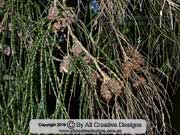

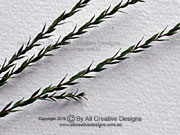
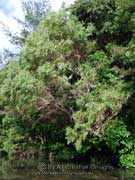
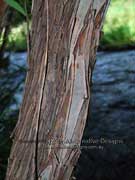


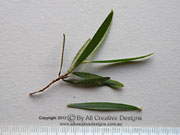
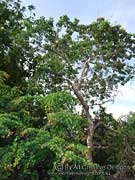


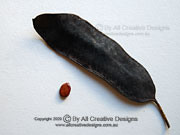
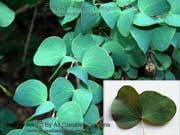



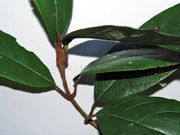
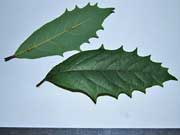
tn.jpg)

tn.jpg)
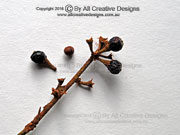
tn.jpg)
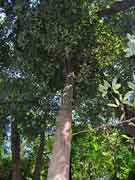
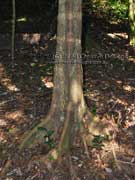
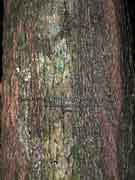
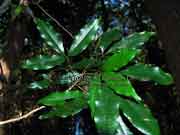
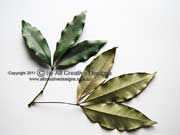

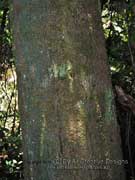
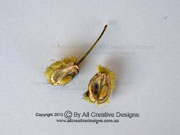
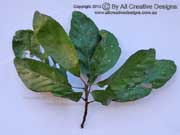
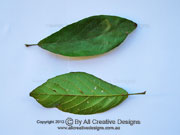
tn.jpg)
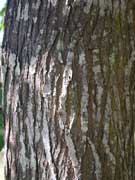
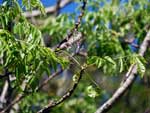
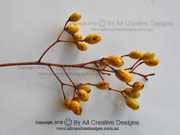


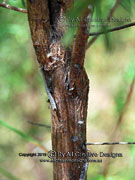
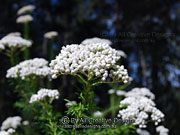
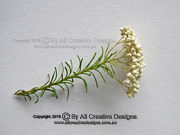
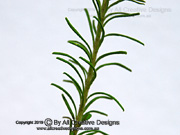

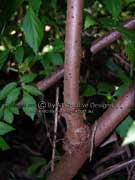
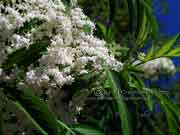
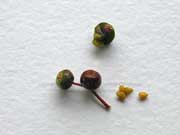
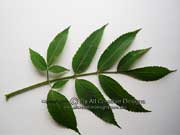

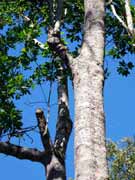
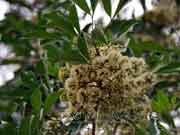
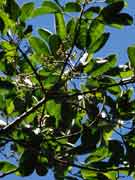

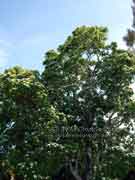
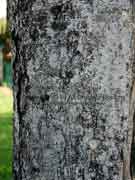

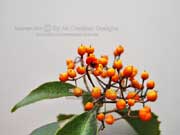
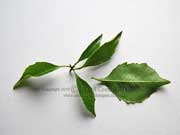
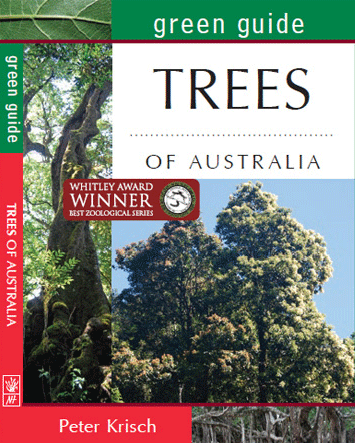
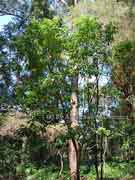
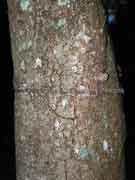

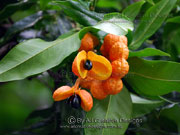



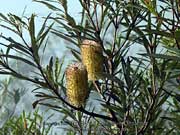
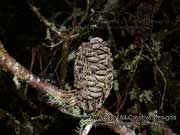
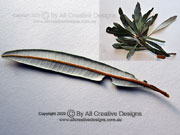


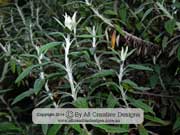

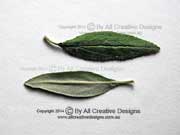

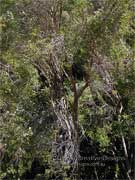
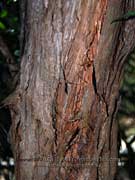
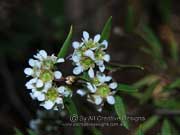
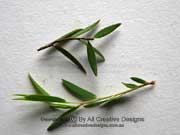

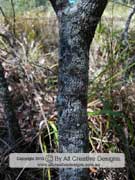
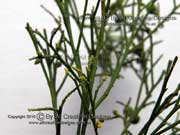
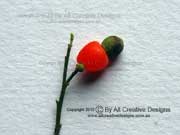


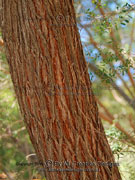
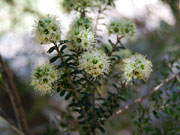

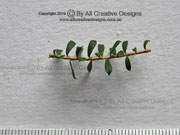

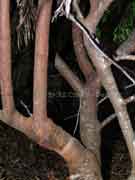
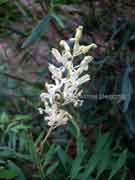
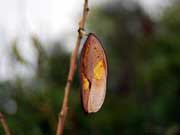
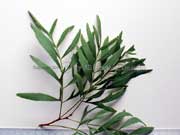
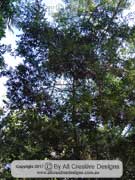
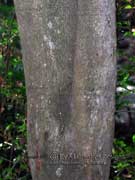

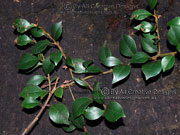

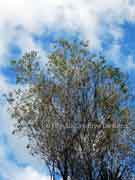
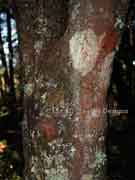
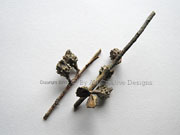
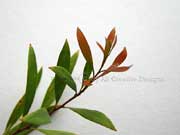
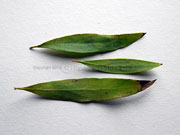
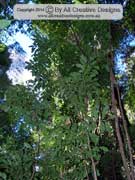


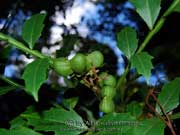
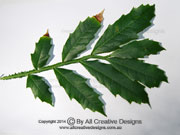
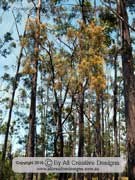

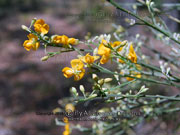
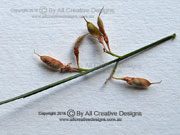

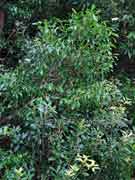

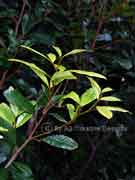

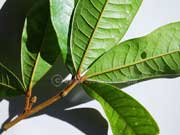
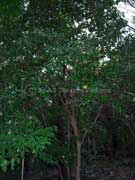

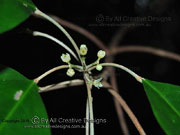

tn.jpg)

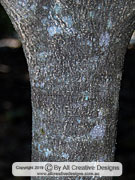
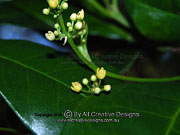

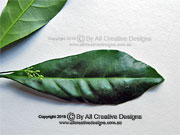
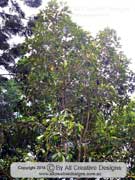
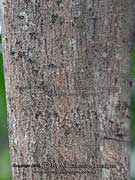
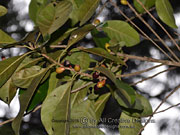



tn.jpg)
